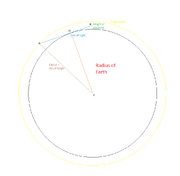- 11,088
- 12,678
Might as well generalize to a spherical cap formula, given that I think it isn't as complicated as I initially though.
Let R be planet radius, h be observer height, H be cloud height and T be cloud Thickness.
As reasoned above the distance along the ground is R*arccos(R/R+h) + R*arccos(R/R+H).
In the following we wish to model things as a Spherical sector (That will spare us intergrating over a spherical cone).
For that purpose we wish to know half the cone angle, which we name phi (i.e., the angle between the rim of the cap and the direction to the middle of the cap as seen from the sphere center, to quote wikipedia)
phi (in radians) = 2*pi * (R*arccos(R/R+h) + R*arccos(R/R+H) / 2*pi*R) = arccos(R/R+h) + arccos(R/R+H)
as (R*arccos(R/R+h) + R*arccos(R/R+H) / 2*pi*R) is the precentage of our distance from the whole planet circumference.
Now H high above our earth surface is the base of the clouds. Hence the Volume of stuff between the cloud base and earth's center is given by the Volume of the spherical cap with radius R+H and half the cone angle phi.
Volume of this spherical sector should be (as per wikipedia):
V1 = 2/3 * pi * (R+H)^3 * (1-cos(phi))
Now directly above the surface of the spherical sector we just modeled is another T meter of clouds. The Volume between the top of the clouds and the center of earth should be a spherical sector with radius R+H+T and half the cone angle phi.
Hence it's Volume is:
V2 = 2/3 * pi * (R+H+T)^3 * (1-cos(phi))
The Volume covered by clouds is exactly the difference between V2 and V1 then:
V2 - V1 = 2/3 * pi * (R+H+T)^3 * (1-cos(phi)) - 2/3 * pi * (R+H)^3 * (1-cos(phi))
= 2/3 * pi * (1-cos(phi)) * ((R+H+T)^3 - (R+H)^3)
= 2/3 * pi * ( 1-cos( arccos(R/R+h) + arccos(R/R+H) ) ) * ((R+H+T)^3 - (R+H)^3)
= 2/3 * pi * ( 1- (R/R+h)*(R/R+H) + sin(arccos(R/R+h))*sin(arccos(R/R+H)) ) * ((R+H+T)^3 - (R+H)^3)
= 2/3 * pi * ( 1- (R/R+h)*(R/R+H) + sqrt(1-(R/R+h)^2)*sqrt(1-(R/R+H)^2) ) * ((R+H+T)^3 - (R+H)^3)
Where from the 3rd into the 4th row the addition theorem for cosinus was used and from the 4th into the 5th row the identity sinus(x) = sqrt(1-cos(x)^2).
So Cloud Volume = 2/3 * pi * ( 1- (R/R+h)*(R/R+H) + sqrt(1-(R/R+h)^2)*sqrt(1-(R/R+H)^2) ) * ((R+H+T)^3 - (R+H)^3)
... right?
That aside, again my question: Would Visibility usually be a concern for us?
Let R be planet radius, h be observer height, H be cloud height and T be cloud Thickness.
As reasoned above the distance along the ground is R*arccos(R/R+h) + R*arccos(R/R+H).
In the following we wish to model things as a Spherical sector (That will spare us intergrating over a spherical cone).
For that purpose we wish to know half the cone angle, which we name phi (i.e., the angle between the rim of the cap and the direction to the middle of the cap as seen from the sphere center, to quote wikipedia)
phi (in radians) = 2*pi * (R*arccos(R/R+h) + R*arccos(R/R+H) / 2*pi*R) = arccos(R/R+h) + arccos(R/R+H)
as (R*arccos(R/R+h) + R*arccos(R/R+H) / 2*pi*R) is the precentage of our distance from the whole planet circumference.
Now H high above our earth surface is the base of the clouds. Hence the Volume of stuff between the cloud base and earth's center is given by the Volume of the spherical cap with radius R+H and half the cone angle phi.
Volume of this spherical sector should be (as per wikipedia):
V1 = 2/3 * pi * (R+H)^3 * (1-cos(phi))
Now directly above the surface of the spherical sector we just modeled is another T meter of clouds. The Volume between the top of the clouds and the center of earth should be a spherical sector with radius R+H+T and half the cone angle phi.
Hence it's Volume is:
V2 = 2/3 * pi * (R+H+T)^3 * (1-cos(phi))
The Volume covered by clouds is exactly the difference between V2 and V1 then:
V2 - V1 = 2/3 * pi * (R+H+T)^3 * (1-cos(phi)) - 2/3 * pi * (R+H)^3 * (1-cos(phi))
= 2/3 * pi * (1-cos(phi)) * ((R+H+T)^3 - (R+H)^3)
= 2/3 * pi * ( 1-cos( arccos(R/R+h) + arccos(R/R+H) ) ) * ((R+H+T)^3 - (R+H)^3)
= 2/3 * pi * ( 1- (R/R+h)*(R/R+H) + sin(arccos(R/R+h))*sin(arccos(R/R+H)) ) * ((R+H+T)^3 - (R+H)^3)
= 2/3 * pi * ( 1- (R/R+h)*(R/R+H) + sqrt(1-(R/R+h)^2)*sqrt(1-(R/R+H)^2) ) * ((R+H+T)^3 - (R+H)^3)
Where from the 3rd into the 4th row the addition theorem for cosinus was used and from the 4th into the 5th row the identity sinus(x) = sqrt(1-cos(x)^2).
So Cloud Volume = 2/3 * pi * ( 1- (R/R+h)*(R/R+H) + sqrt(1-(R/R+h)^2)*sqrt(1-(R/R+H)^2) ) * ((R+H+T)^3 - (R+H)^3)
... right?
That aside, again my question: Would Visibility usually be a concern for us?



